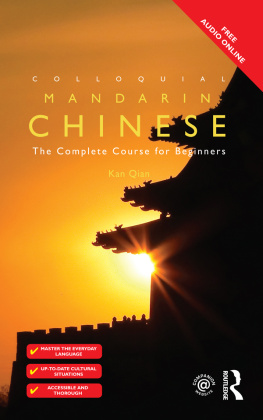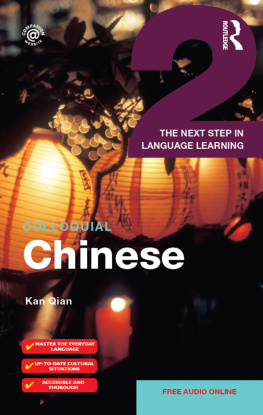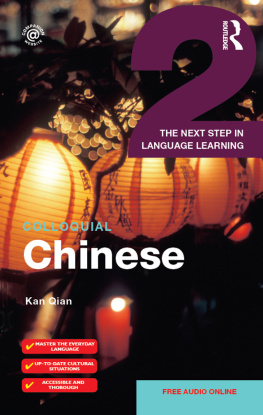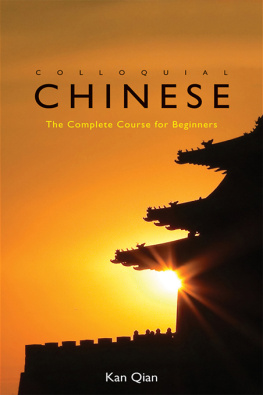Qian Kan - Colloquial Mandarin Chinese: The Complete Course for Beginners
Here you can read online Qian Kan - Colloquial Mandarin Chinese: The Complete Course for Beginners full text of the book (entire story) in english for free. Download pdf and epub, get meaning, cover and reviews about this ebook. year: 2015, publisher: Routledge, genre: Children. Description of the work, (preface) as well as reviews are available. Best literature library LitArk.com created for fans of good reading and offers a wide selection of genres:
Romance novel
Science fiction
Adventure
Detective
Science
History
Home and family
Prose
Art
Politics
Computer
Non-fiction
Religion
Business
Children
Humor
Choose a favorite category and find really read worthwhile books. Enjoy immersion in the world of imagination, feel the emotions of the characters or learn something new for yourself, make an fascinating discovery.
Colloquial Mandarin Chinese: The Complete Course for Beginners: summary, description and annotation
We offer to read an annotation, description, summary or preface (depends on what the author of the book "Colloquial Mandarin Chinese: The Complete Course for Beginners" wrote himself). If you haven't found the necessary information about the book — write in the comments, we will try to find it.
Colloquial Chinese: The Complete Course for Beginners has been carefully developed by an experienced teacher to provide a step-by-step course to Chinese as it is written and spoken today.
Combining a clear, practical and accessible style with a methodical and thorough treatment of the language, it equips learners with the essential skills needed to communicate confidently and effectively in Chinese in a broad range of situations. No prior knowledge of the language is required.
Colloquial Chinese is exceptional; each unit presents a wealth of grammatical points that are reinforced with a wide range of exercises for regular practice. A full answer key, a grammar summary, bilingual glossaries and English translations of dialogues can be found at the back as well as useful vocabulary lists throughout.
Key features include:
- A clear, user-friendly format designed to help learners progressively build up their speaking, listening, reading and writing skills
- Jargon-free, succinct and clearly structured explanations of grammar
- An extensive range of focused and dynamic supportive exercises
- Realistic and entertaining dialogues covering a broad variety of narrative situations
- Helpful cultural points explaining the customs and features of life in China
- An overview of the sounds of Chinese
Balanced, comprehensive and rewarding, Colloquial Chinese is an indispensable resource both for independent learners and students taking courses in Chinese.
Audio material to accompany the course is available to download free in MP3 format from www.routledge.com/cw/colloquials. Recorded by native speakers, the audio material features the dialogues and texts from the book and will help develop your listening and pronunciation skills.
Qian Kan: author's other books
Who wrote Colloquial Mandarin Chinese: The Complete Course for Beginners? Find out the surname, the name of the author of the book and a list of all author's works by series.






![Yi Ren - Mandarin Chinese for Beginners: Learning Conversational Chinese / Mastering Conversational Chinese [Book]](/uploads/posts/book/146887/thumbs/yi-ren-mandarin-chinese-for-beginners-learning.jpg)






 ColloquialChineseMandarinTHE COLLOQUIAL SERIESSeries Adviser: Gary King The following languages are available in the Colloquial series:
ColloquialChineseMandarinTHE COLLOQUIAL SERIESSeries Adviser: Gary King The following languages are available in the Colloquial series: First published 1996 by Routledge Reprinted 1997, 1998, 2002, 2003 (twice), 2004, 2005, 2006 Revised edition 1999 This edition published 2009 by Routledge 2 Park Square, Milton Park, Abingdon, Oxon OX14 4RN Simultaneously published in the USA and Canada by Routledge 711 Third Avenue, New York, NY 10017 Routledge is an imprint of the Taylor & Francis Group, an informa business 1996, 2009 Kan Qian Typeset in 9.5/13pt Helvetica by Graphicraft Limited, Hong Kong All rights reserved. No part of this book may be reprinted or reproduced or utilised in any form or by any electronic, mechanical, or other means, now known or hereafter invented, including photocopying and recording, or in any information storage or retrieval system, without permission in writing from the publishers. 2nd ed. p. cm. (The colloquial series) 1. (The colloquial series) 1.
First published 1996 by Routledge Reprinted 1997, 1998, 2002, 2003 (twice), 2004, 2005, 2006 Revised edition 1999 This edition published 2009 by Routledge 2 Park Square, Milton Park, Abingdon, Oxon OX14 4RN Simultaneously published in the USA and Canada by Routledge 711 Third Avenue, New York, NY 10017 Routledge is an imprint of the Taylor & Francis Group, an informa business 1996, 2009 Kan Qian Typeset in 9.5/13pt Helvetica by Graphicraft Limited, Hong Kong All rights reserved. No part of this book may be reprinted or reproduced or utilised in any form or by any electronic, mechanical, or other means, now known or hereafter invented, including photocopying and recording, or in any information storage or retrieval system, without permission in writing from the publishers. 2nd ed. p. cm. (The colloquial series) 1. (The colloquial series) 1.  Acknowledgements I am indebted to Dr Andrew Brown, who helped me throughout the writing of the first edition of this book. Not only did he spend many hours polishing my English, but he also put himself in the position of a learner for this book. The criticism and comments he made were extremely helpful in enabling me to search for the most appropriate way of expressing many language points. Over the last ten years or so, many teachers and learners who used the first and/or the revised edition of this book wrote to me with their extremely useful feedback, to whom I am very grateful. I would particularly like to thank Dr Yip Poching, Chen Guangqin, Wang Xiaoning, Yu Feixia and Guo Zhiyan for taking the time to provide very specific and good suggestions. My special thanks go to Kan Jia for countless hours of word processing, pinyin annotation and proof-reading the Chinese texts.
Acknowledgements I am indebted to Dr Andrew Brown, who helped me throughout the writing of the first edition of this book. Not only did he spend many hours polishing my English, but he also put himself in the position of a learner for this book. The criticism and comments he made were extremely helpful in enabling me to search for the most appropriate way of expressing many language points. Over the last ten years or so, many teachers and learners who used the first and/or the revised edition of this book wrote to me with their extremely useful feedback, to whom I am very grateful. I would particularly like to thank Dr Yip Poching, Chen Guangqin, Wang Xiaoning, Yu Feixia and Guo Zhiyan for taking the time to provide very specific and good suggestions. My special thanks go to Kan Jia for countless hours of word processing, pinyin annotation and proof-reading the Chinese texts. 1 Initials (Audio 1:2) There are twenty-three initials (some people regard w and y as semi-vowels) in modern Chinese.
1 Initials (Audio 1:2) There are twenty-three initials (some people regard w and y as semi-vowels) in modern Chinese.